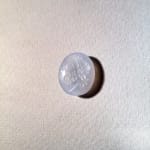Classical Revival Intaglio Depicting the Head of Jupiter, 18th Century CE
Chalcedony
OS.447
Intaglios are cut into the surface of stone using a lathe, diamond powder and metal tools. The practice of gem engraving has a long history, first carried out in Egypt...
Intaglios are cut into the surface of stone using a lathe, diamond powder and metal tools. The practice of gem engraving has a long history, first carried out in Egypt and ancient Mesopotamia. In the eighteenth century, the ancient techniques were revived, partly to meet the demand for ancient gems amongst scholars and collectors. Sometimes ancient examples were copied exactly, either with the intent to deceive, or in homage to the original. Collected for centuries, these engraved gems are remarkable for their miniature scale and intricate workmanship.
This delicate chalcedony intaglio depicts the Roman god Jupiter (known as Zeus in the Greek world). In antiquity, both intaglios and cameos were used as seals/amulets to invoke the power of the deity depicted. Jupiter, the supreme god in the Roman pantheon, had particular associations with the sky and thunder. In this example he is depicted diademed and facing left.
This delicate chalcedony intaglio depicts the Roman god Jupiter (known as Zeus in the Greek world). In antiquity, both intaglios and cameos were used as seals/amulets to invoke the power of the deity depicted. Jupiter, the supreme god in the Roman pantheon, had particular associations with the sky and thunder. In this example he is depicted diademed and facing left.



